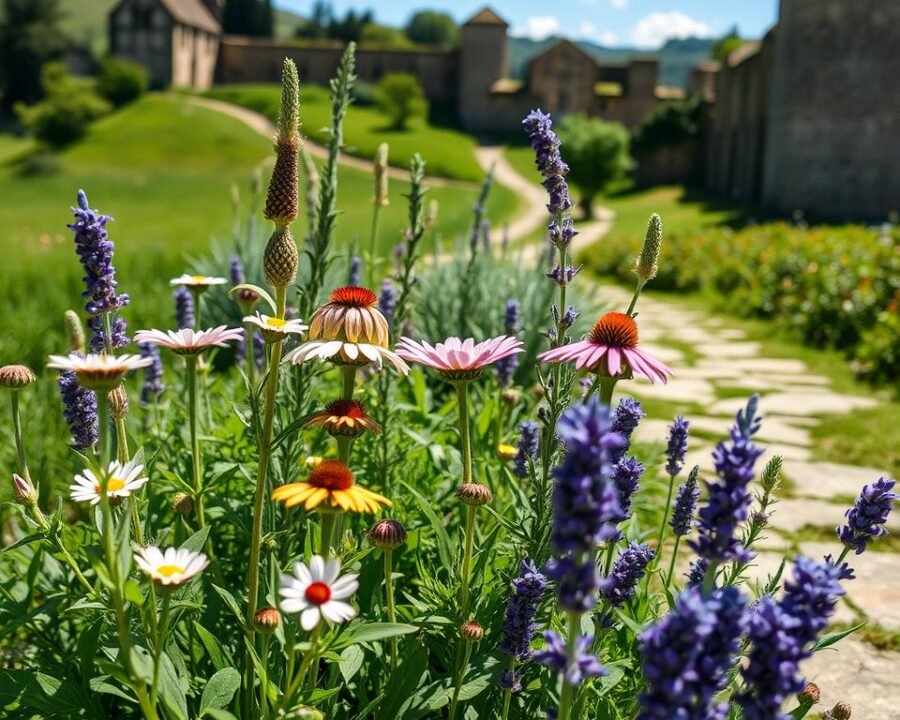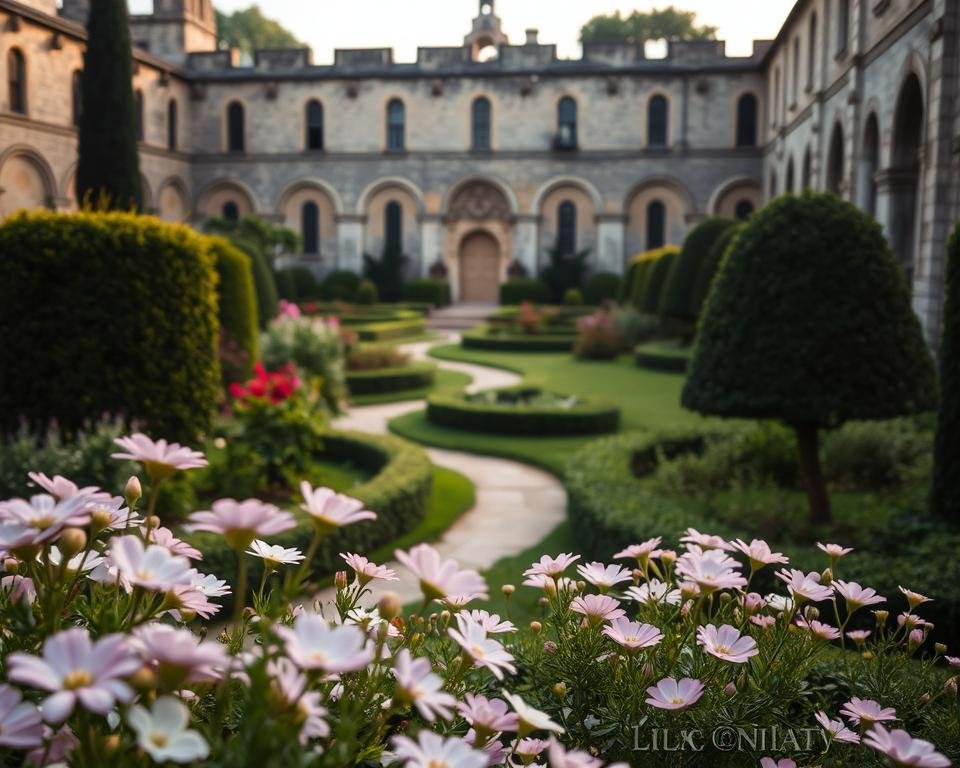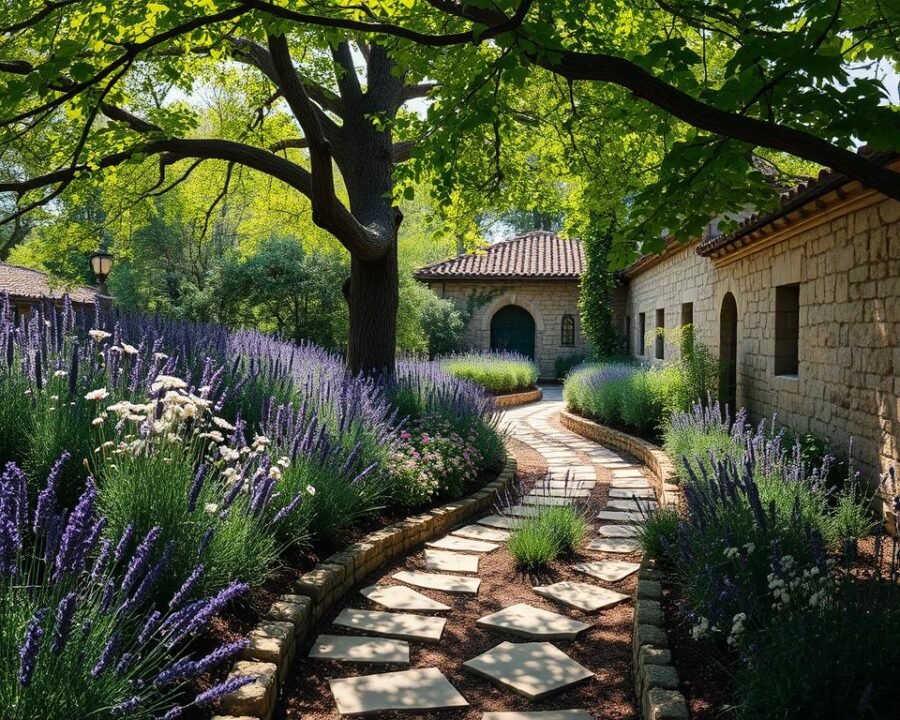In a world where time seems to be moving at an unprecedented pace, finding a serene escape is more valuable than ever. Our Monastery Garden is a haven that combines centuries of tradition with modern gardening practices, creating a unique place for reflection and growth.
We draw inspiration from the rich heritage of Benedictine gardens, where plants were not only a source of healing but also a connection to the spiritual. Our Monastery Garden Krauter and Blumen preserves this ancient wisdom, offering a peaceful retreat in today’s hectic world.
Key Takeaways
- Discover the historical significance of Benedictine monastery gardens.
- Learn how our garden combines traditional practices with modern gardening.
- Explore the symbolic layout and medicinal herbs in our garden.
- Find out how to create your own monastery-inspired garden spaces.
- Understand the relevance of monastery gardens to modern life.
The Rich Heritage of Monastery Garden Krauter and Blumen
Our Monastery Garden Krauter and Blumen draws inspiration from the rich heritage of medieval monastery gardens. The history of monastic horticulture is a long and varied one, reflecting both the spiritual and practical needs of monastic communities.
Origins in Benedictine Tradition
The roots of our garden lie in the Benedictine tradition, which emphasized the importance of work, prayer, and hospitality. Two significant documents from the 9th century provide insight into the idealized monastery gardens of the Early Middle Ages: the Plan of Saint Gall and the poem “Hortulus” by Walahfrid Strabo.
- The Plan of Saint Gall offers a detailed blueprint of an exemplary monastery, including various garden spaces such as the cloister garden, medicinal herb garden, vegetable garden, and fruit garden.
- These historical plans reveal a sophisticated understanding of plant combinations and garden design that we incorporate into our Monastery Garden Krauter and Blumen today.
From Medieval Times to Modern Day
Through the centuries, monastery gardens like ours have adapted to changing times while maintaining core principles of utility, beauty, and spiritual symbolism. The name of plants documented in early texts continues to influence our selection and arrangement of botanical specimens. Our garden serves as a living museum, connecting visitors to this unbroken tradition.
We draw name from the past, honoring the legacy of monastic horticulture while demonstrating how monastery garden principles remain relevant in time.
By embracing this heritage, we create a serene and beautiful garden that showcases the best of monastic horticulture, featuring a variety of plants that have been carefully chosen for their utility, beauty, and spiritual significance within our monastery setting.
The Sacred Symbolism of Our Monastery Garden
In the heart of our Monastery Garden Krauter und Blumen lies a profound symbolism that resonates deeply with our spiritual journey. Our garden is designed to be more than just a beautiful space; it’s a reflection of the deep theological roots that nourish our community. As we explore the symbolism embedded in our garden, we uncover layers of meaning that connect us to the natural world and to our faith heritage.
The Hortus Conclusus: Enclosed Garden Theology
The concept of the Hortus Conclusus, or enclosed garden, is central to understanding the symbolism of our Monastery Garden. This medieval concept represents a paradise on earth, a space enclosed and protected from the outside world. Our garden embodies this idea, creating a sanctuary that fosters spiritual growth and contemplation. The enclosed nature of the garden symbolizes the soul’s journey towards God, protected from worldly distractions.
Water, Life, and Spiritual Renewal
Water features are integral to our Monastery Garden, serving both practical and symbolic purposes. According to Sylvia Landsberg, a late garden historian, the three forms of water—bubbling spring, flowing stream, and still pool—symbolize the Holy Trinity. For monks, the sound of water was a form of liturgy, calling them to prayer and contemplation. Our garden incorporates these elements, creating a serene atmosphere that invites reflection and spiritual renewal.
| Garden Element | Symbolism |
|---|---|
| Water Features | Symbolize the Holy Trinity; represent life and spiritual renewal |
| Enclosed Garden | Represents paradise on earth; fosters spiritual growth and contemplation |
| Herbs and Flowers | Used for healing, cooking, and symbolizing various virtues |
Layout and Design of Our Traditional Monastery Garden
In our Monastery Garden Krauter und Blumen, we blend historical authenticity with modern gardening techniques. The garden’s design is rooted in the rich history of monastic gardening traditions, where every element serves a purpose, from the spiritual to the practical.
The Four-Square Garden Structure
The foundation of our garden’s layout is the four-square structure, a traditional design that symbolizes the harmony and balance found in nature. This design is not only aesthetically pleasing but also facilitates a deeper connection with the natural world. The four-square layout allows us to categorize and cultivate a diverse range of plants in an organized manner, making it easier for visitors to navigate and appreciate the garden.
Raised Beds and Pathways: Form Meets Function
Our garden features raised beds that are both functional and visually appealing. We’ve constructed these beds using traditional methods and natural materials, ensuring they complement the plants while providing optimal growing conditions. Each bed is named and organized according to historical documents, such as the Plan of Saint Gall and Walahfrid Strabo’s “Hortulus.” The elevated design makes tending and harvesting easier, creating visual interest through varying heights and textures.
The pathways in our garden serve both practical and symbolic purposes. They allow easy access to all plants, while encouraging a meditative walking practice. We’ve designed the pathways in a way that guides visitors through the garden in a meaningful sequence, revealing the relationships between different plant collections. By combining raised beds with well-planned pathways, we create a garden that is both beautiful and efficient to maintain.
Medicinal Herbs in Our Monastery Garden Krauter and Blumen
Our Monastery Garden Krauter und Blumen is home to a diverse array of medicinal herbs, each with its own unique history and benefits. The tradition of cultivating these healing plants dates back centuries, reflecting a legacy of care and healing that continues to inspire people today.

Healing Herbs and Their Historical Uses
The historical significance of medicinal herbs in monastic gardens cannot be overstated. The poem “hortulus” by Walahfrid Strabo, written around 840, lists 24 medicinal plants in verse form, highlighting the importance of these gardens in medieval times.
‘The monks’ herb gardens were, if you will, acts of mercy themselves. Planted with care and studied with precision, they became places of healing not just for the community within, but for those outside the cloister as well.’
Herbs like sage, rosemary, and even belladonna were cultivated with a balance of scientific understanding and spiritual purpose, demonstrating the holistic approach to health that characterized monastic medicine.
These healing herbs were not only used for their medicinal properties but also played a significant role in the spiritual and daily life of the monastic community. Understanding the historical uses of these plants provides valuable insights into the development of herbal medicine and its continued relevance in modern times.
Cultivating Your Own Medicinal Herb Collection
Cultivating your own medicinal herb collection can be a rewarding experience, connecting you to an ancient tradition of healing and self-sufficiency. To start, choose essential healing herbs that are both beautiful and beneficial, such as lavender for calming, mint for digestion, and thyme for respiratory health. When selecting a location for your herb garden, consider the specific needs of each plant for sunlight, water, and soil type.
- Begin with small containers if space is limited, as many medicinal herbs thrive in pots and can be grown on balconies or windowsills.
- Harvest your herbs at the optimal time, usually just before flowering, when their medicinal properties are at their peak.
- Learn the proper way to dry and store your medicinal herbs to preserve their potency and flavor for year-round use.
- Research the traditional name and uses of each herb you grow, connecting to the rich history of monastic herbal medicine.
By following these guidelines and embracing the tradition of monastic herbalism, you can create a thriving garden that not only provides natural remedies but also serves as a sanctuary for relaxation and contemplation. As you cultivate your medicinal herb collection, you’ll be participating in a timeless tradition that has brought health and well-being to people for centuries, showing them a better way to live in harmony with nature.
Culinary Herbs: From Garden to Table
In our Monastery Garden Krauter and Blumen, we cultivate a diverse array of culinary herbs that bring flavor and fragrance to our kitchen. The monastic tradition of growing herbs for cooking dates back centuries, and we’re pleased to share our knowledge with you.
Essential Cooking Herbs in Monastic Tradition
Our garden is home to a variety of herbs that are staples in monastic cooking. These include parsley, dill, and rosemary, among others. We use these herbs to add flavor to our dishes and to create herbal remedies.
- Parsley and dill are used in a variety of dishes, from soups to salads.
- Rosemary is a hardy herb that is often used in roasted meats and vegetables.
- Other herbs, such as thyme and oregano, are used to add depth and complexity to our cooking.
Harvesting and Preserving Techniques
To make the most of our culinary herbs, we employ traditional harvesting and preserving techniques. The optimal time for harvesting most herbs is in the morning, after the dew has dried but before the day’s heat intensifies the volatile oils.
- We harvest leaf herbs before they flower, when their flavor and aroma are at their peak.
- Seed herbs are harvested after the seeds have formed, ensuring the best flavor and texture.
- Our preservation methods include air-drying, freezing, and creating herb-infused oils and vinegars.
By following these traditional methods, you can enjoy your favorite culinary herbs throughout the year and create a monastery-inspired pantry that’s full of flavor and fragrance.
Flowers of the Monastery Garden: Beauty and Purpose
In the serene surroundings of our Monastery Garden Krauter and Blumen, flowers play a vital role in enhancing both the beauty and functionality of the garden. The integration of flowers among herbs and vegetables is a deliberate design choice, rooted in traditional monastic practices that recognized the beneficial relationships between different plant species.

Symbolic Blooms: Roses, Lilies, and Lavender
The flowers in our Monastery Garden are chosen not only for their beauty but also for their symbolic meanings. Roses, lilies, and lavender are among the blooms that add fragrance and color to the garden, each carrying its own significance. For instance, roses are often associated with love and compassion, while lilies symbolize purity and refined beauty. Lavender, with its calming scent, represents peace and serenity.
These symbolic blooms are carefully integrated into the garden design, creating a tapestry of color and meaning that enhances the visitor’s experience. By labeling each flower with its name and significance, we help visitors understand the thoughtful curation behind our garden.
Companion Planting for a Balanced Garden Ecosystem
Our Monastery Garden Krauter and Blumen employs traditional companion planting techniques to create a balanced, self-sustaining ecosystem. By interplanting flowers with herbs and vegetables, we leverage the beneficial relationships between different plant species to enhance the garden’s health and productivity.
For example, marigolds, nasturtiums, and calendula are strategically placed throughout our garden beds to repel pests naturally and attract beneficial insects. Each flower in our companion planting scheme is chosen for its specific properties, whether it’s to fix nitrogen in the soil, deter harmful insects, or attract pollinators. This approach not only protects the garden but also creates a vibrant tapestry of color and fragrance that enhances the garden’s beauty and life.
By understanding and applying these traditional companion planting techniques, we create a resilient ecosystem where plants support each other’s growth and health. This living demonstration of interdependence is at the heart of our Monastery Garden’s design, showcasing the harmony and balance achievable through thoughtful garden planning.
Creating Your Own Monastery-Inspired Herbal Tea Blends
Blending herbal teas inspired by monastery gardens is a simple yet profound way to connect with nature. We find that the process of creating these blends not only fosters a deeper appreciation for the natural world but also encourages mindfulness in our daily lives.
Traditional Monastic Tea Recipes
Traditional monastic tea recipes often feature a combination of herbs grown in the monastery gardens, such as chamomile, lavender, and lemon balm. These herbs are carefully selected for their medicinal properties and their ability to promote relaxation and well-being. For instance, a blend that includes fruit infusions like apple or berries can add a delightful twist to traditional herbal teas.
Some of our favorite monastic tea recipes include a soothing chamomile and lavender blend, perfect for unwinding after a long day. We also enjoy a refreshing peppermint tea, which is great for digestion.
Proper Preparation Methods for Maximum Benefits
To fully enjoy the benefits of monastery-inspired herbal teas, it’s essential to use proper preparation methods. Always use fresh, pure water heated to a full boil (100°C) when preparing herbal infusions. The steeping time can vary, but generally, 7-10 minutes is recommended to fully release the beneficial compounds and flavors.
- Use fresh, pure water heated to 100°C for safety and optimal extraction.
- Steep herbal teas for 7-10 minutes to release the full flavor and benefits.
- Cover your teapot during steeping to preserve the essential oils and aromas.
- Fruit-based teas benefit from slightly longer steeping times.
- Each tea blend has its own ideal preparation method, so feel free to experiment.
As people around the world today seek natural alternatives to commercial beverages, they’re rediscovering the joy of traditional herbal teas. By embracing these timeless practices, we can cultivate a deeper connection with nature and enhance our overall well-being.
Conclusion: Embracing the Timeless Wisdom of Monastery Gardens
As we reflect on the serene beauty of Monastery Garden Krauter and Blumen, it’s clear that its legacy extends far beyond its physical boundaries. Our Monastery Garden stands as a living testament to the enduring wisdom of monastic gardening traditions that have nourished body and soul for centuries.
We invite you to incorporate elements of monastery garden design into your own spaces, whether you have acres of land or simply a few pots on a windowsill. By growing even a small selection of herbs, flowers, or fruit plants, you connect yourself to this ancient tradition and its profound respect for the natural world.
The principles of balance, usefulness, and beauty that guided monastery gardens throughout time remain relevant in today’s fast-paced world. As people around the world embrace these timeless practices, they often discover that tending a garden becomes a form of meditation, a way to slow down and reconnect with life’s essential rhythms.
We hope our exploration of monastery garden traditions has inspired you to see your own garden spaces through new eyes, recognizing their potential as places of healing and renewal. The name “Krauter and Blumen” reminds us that herbs and flowers have always been at the heart of monastery gardens—humble plants that offer extraordinary gifts to those who cultivate them with knowledge and respect.
